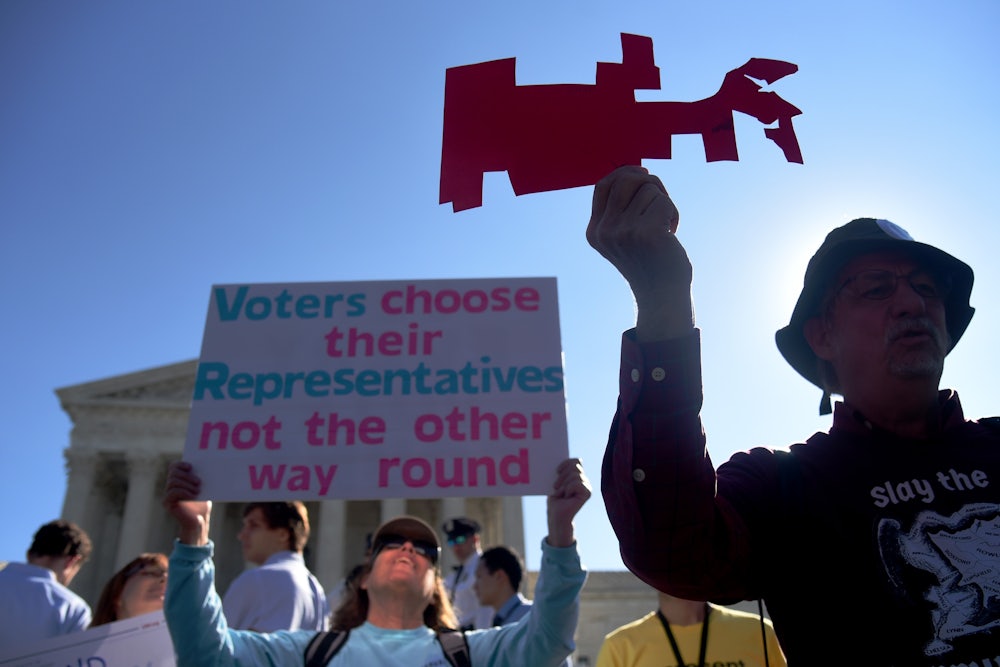The Supreme Court’s decision to hear Alexander v. South Carolina State Conference of the NAACP is at least a little surprising because it puts the justices squarely back into an area of law that they have openly said they found a headache—and one they had seemingly found a way to neatly sidestep last decade.
The case, which the court will hear on October 11, involves Black voters’ inequitable treatment in congressional redistricting after the 2020 census. At issue is whether South Carolina Republican legislators created an unconstitutional racial gerrymander when they surgically removed Black voters from a Charleston-area district in order to shore up a vulnerable incumbent’s electoral prospects.
Alexander hasn’t drawn the attention that suits over maps in states like Alabama and Louisiana have, but it’s a big case that could open the door for state legislatures to blatantly draw racially discriminatory districts in the name of partisan gerrymandering.
The conundrum with which courts have long wrestled in racial gerrymandering cases is figuring out whether race or politics “predominated” in map drawers’ decision-making, no easy question in the South, where race and party strongly overlap. In 2016, former Justice Stephen Breyer bemoaned in one oral argument that racial gerrymandering cases required the court to spend “the entire term reviewing 5,000-page records” in order to decide, sometimes precinct by precinct, whether it was race or politics that drove lawmakers’ decisions about drawing a district. Justice Samuel Alito agreed, calling the court’s racial gerrymandering jurisprudence “very, very complicated” and “an invitation to litigation.”
Then in 2017 the court seemed to have a light-bulb moment: It didn’t matter. In an opinion in Cooper v. Harris by Justice Elena Kagan, notably joined by Justice Clarence Thomas, the court ruled that when it comes to racial gerrymandering, “the sorting of voters on the grounds of their race remains suspect even if race is meant to function as a proxy for other (including political) characteristics.” In short, neither sorting voters by race for racial reasons nor sorting them by race for reasons of partisan gerrymandering is permissible.
Given Cooper, South Carolina’s congressional map seems a straightforward racial gerrymander. The case concerns two districts: the 1st, an increasingly competitive, white-majority coastal seat anchored in Charleston, and the 6th, a neighboring inland Black-majority district, which Democratic Representative Jim Clyburn has long represented.
According to the census, the Charleston-centered 1st District was overpopulated by almost exactly the same number of people by which the inland 6th District was underpopulated. Given that, it would have been fairly easy for legislators to equalize district population by simply shifting around 85,000 people from the 1st to the 6th.
South Carolina Republicans took a more aggressive tack, however, moving almost 53,000 people from the 6th District into the 1st District and then moving a different 140,000 people back to the 6th. These massive population shifts fell heavily along surgically precise racial lines, moving 62 percent of Charleston’s Black population from the 1st to the 6th. They shifted all but one Charleston County voting-tabulation district with more than 1,000 Black voters out of the 1st District.
A three-judge panel found that the moves were designed to add Republican-leaning white voters to the 1st District while also keeping the district’s Black voting-age population at or below 17 percent. Any higher percentage, GOP map drawers believed, would make the 1st competitive for Democrats. Although they claimed that they were driven by partisan rather than racial considerations, the court found that they knew that race was a much stronger predictor of politics than recent election results and so used it as a scalpel to slice the most reliable Democrats away from the district.
South Carolina defends the map with a number of overlapping and sometimes contradictory arguments. On the one hand, it argues that political data drove map drawers’ decision-making more than racial data. By concluding otherwise, South Carolina contends the district court confused the correlation of race and politics in South Carolina with the predominance of race. The mere fact that Black voters may have been disproportionately affected doesn’t mean race predominated—or so South Carolina asserts.
Simultaneously, South Carolina also argues: So what? The legislature had a right to let the cuts track racial lines because its goal, shoring up GOP incumbent Representative Nancy Mace, was a legitimate state policy objective. According to South Carolina, Black voters must show that it was possible to draw an equally gerrymandered map without targeting them.
The goal of South Carolina’s project is clear: to pry back open the door to a broad “it was just politics” defense of racially discriminatory maps upon which Cooper slammed the door. That case was only decided six years ago, but the high court, alas, is much changed. And precedent isn’t exactly what it used to be. If South Carolina succeeds, lawmakers in places where race and politics are joined at the hip (which is to say most of the South) will be able to push back on claims of racial gerrymandering by saying, “We aren’t prejudiced against voters of color—we were simply targeting Democrats; the fact that those Democrats happen to be people of color is coincidence.”
So far, the Alexander case has been, if not quite a sleeper, not splashy front-page news, perhaps because of a misguided sense of its political stakes. Unlike last term’s Alabama Voting Rights Act case, and pending VRA cases in Louisiana and Georgia, the South Carolina case wouldn’t lead to the creation of any new Black-majority districts. In fact, undoing South Carolina’s racial gerrymandering wouldn’t necessarily create a particularly Democratic district, perhaps only a competitive district that either Democrats or Republicans could win.
But ignoring Alexander would be a mistake. If South Carolina gets its way, partisan gerrymandering could perversely gain equal status with Voting Rights Act compliance as a reason for taking race into account when drawing district lines. And that makes it one of the more disturbing and dangerous cases of the term.










